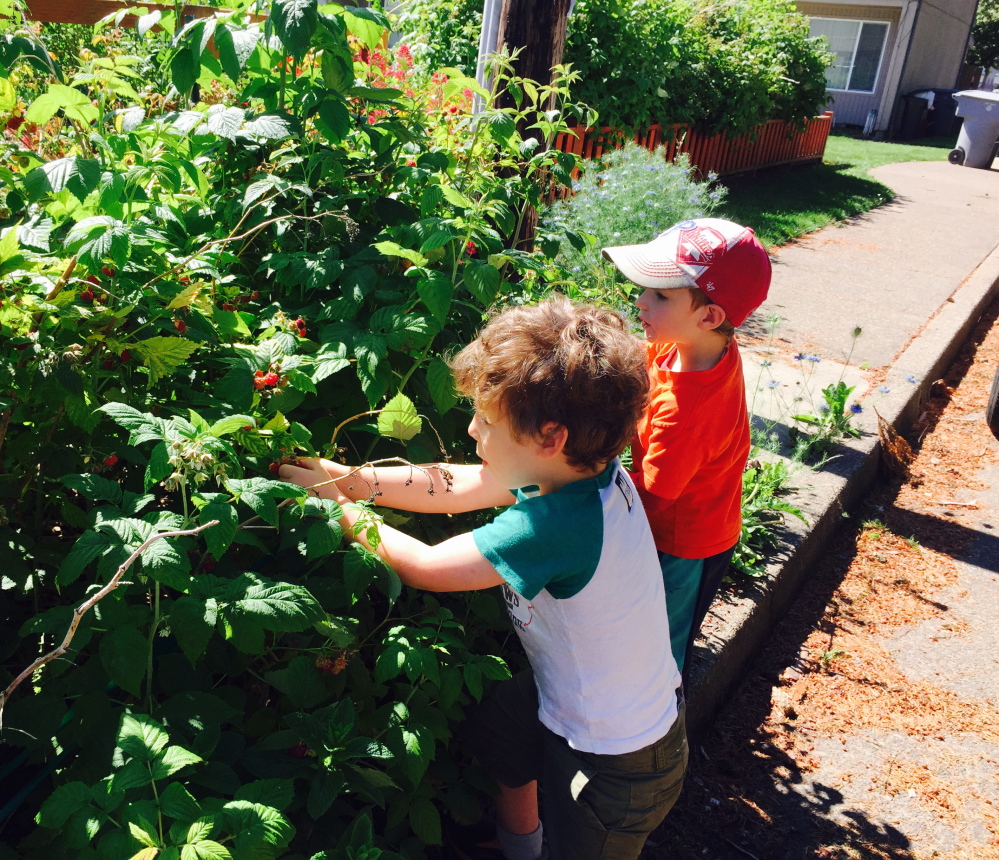My son Theo was born in Oregon four years ago this Father’s Day. Sixteen months later, the urge to be closer to family and a Bowdoin College job lured us back East to Maine. It was a difficult decision that proved to be the right one. We left behind dear friends and treasured foods – fat-marbled Chinook salmon; forest-fresh black and white truffles; and juicy Marionberries, raspberries and cherries; not to mention Willamette Valley wine – in the green college town of Corvallis we were proud to call home for four years.
When I got pregnant with our second son, due this September, my husband proposed a pilgrimage back to Oregon to show Theo where he was born. We thought of it as a “babymoon,” though cross-country travel isn’t that relaxing when co-sleeping with your sprawling preschooler.
I had the excuse of eating for two, so over our jam-packed week earlier this month, I gorged on favorite Pacific Northwest foods. I hoped Theo might follow my lead. As a teething baby in Oregon, he gnawed on any food we gave him, even whole chicken feet, boiled for stock. But he’s more finicky now, so I focused on my swelling belly instead.
I prioritized fish, since I need the extra boost of omega-3 fatty acids during pregnancy. In Brunswick, surrounded by beaches, we’re nearer to fresh seafood than we were in Corvallis, where the sea-stacked rocky coast (the setting for “The Goonies”) was an hour’s drive. And in Maine, cheap “trash” fish options seem more plentiful, too: pollock, hake, redfish. The smelly, dried-out Gulf of Maine sea scallops I spied at an Oregon fish market for $40 a pound made me miss home ($18 a pound here looks cheap by comparison).
But our farmed Atlantic salmon, no matter how sustainably raised, lacks the flavor of brilliant coral wild Pacific salmon. Most days on our trip, I ate at least a nibble.
The best bite was a salmon toast I devoured our first breakfast out West in the other hipster Portland: It was multigrain toast slathered with crème fraîche, avocado, and house-cured salmon, topped with lemon- and olive oil-slicked baby arugula. My food-writing colleague Deena Prichep encouraged the order when we met up that morning at Roman Candle Baking Co. (part of the Stumptown Coffee empire). The bakery makes bread for adjoining sister restaurant Ava Gene’s, much as Standard Baking does for Fore Street here in our Portland. And I couldn’t pass up the strawberry-frosted pop-tart filled with rhubarb compote as a 10 a.m. “dessert.”
We indulged in Oregon’s bounty a month before such produce surfaces in Maine. Oregon strawberries came on the scene in early May, and the week of our visit, farmers markets were rife with raspberries, snap peas, Sun Gold tomatoes and zucchini. The season’s first cherries, too, though I never saw them. Thankfully, dark, sweet Northwest cherries are now in peak form at our local Hannaford. We taught Theo the commandment of “Corvallis kosher”: if a fruit tree or berry cane droops over a public sidewalk, it’s acceptable to pick. His favorite were ruby raspberries he foraged from friends’ yards and an overgrown community garden.
Theo declined the salmon but did eat some offal in nose-to-tail Oregon. The “steak” he ate two nights in a row was actually beef tongue: first, in lengua tacos we ordered in southern Oregon, in the town where the Mexican workers who tend Harry & David’s famous pear orchards live, and next, on our final night, confited tongue with pickled rhubarb at James Beard Foundation-nominated Kachka in Portland. (My friend Deena is co-writing their cookbook!)
We made a point to visit great restaurants in genres that Maine lacks. Oregon boasts better brew pubs with true farm-to-table fare, not to mention Burgerville, a locavore fast food chain that tempura-fries fat asparagus spears, blends local berry shakes and flips antibiotic-free beef patties.
The restaurant we miss most is on the premises of Gathering Together Farm just outside Corvallis. We raced there for lunch upon arrival, enjoying wood-fired, microgreen-topped pizzas and crusty baguettes from the farm’s earth oven, homemade pastas and house charcuterie. Lunch entrees barely push $10.
It’s efficient restaurant economics: The destination restaurant encourages diners to buy produce and pastries from the farm store, and the farm in turn supplies its Chez Panisse-trained chef with surplus produce. Think Chase’s Daily in Belfast, but with an all-organic menu and bucolic farm setting. Calling all chefs: Please open such an affordable restaurant here, say on a farm in Bowdoinham.
Organic local honey-sweetened lemonade was a treat Theo and I both enjoyed in Corvallis. Gathering Together makes a refreshing version, as does its sister restaurant, Nearly Normal’s. And at a crunchy booth at the city’s crowded Saturday riverfront market, the lemonade washes down pad thai and tofu burgers. Somehow, fresh-pressed lemons taste better closer to California.
At the tail end of our trip, we drove to southern Oregon to visit friends, a survivalist taiji instructor-acupuncturist couple who’d decamped from the winter rain-soaked Willamette Valley for the sunnier Applegate Valley. It’s the heart of marijuana country, the Humboldt County of Oregon. The breeze was dank with the reminder that cannabis legalization goes into effect July 1. It was an arid, outlaw, off-the-grid canyon, where hippies fence in their hillside homesteads with keypad-protected gates to keep the meth heads out, wield chainsaws, keep generators to preserve chest freezers invested in whole-animal cuts and buy guns, occasionally firing into the woods to deter trespassers.
When you order a whole lamb in the Applegate Valley, they throw in the testicles and tongue, cuts that weren’t offered when I bought half a grass-fed lamb from Crystal Spring Farm here in Brunswick. Our friends peeled and sliced the testicles into creamy, scallop-like circles, served breaded and fried as “lamb fries.” We also ate the lamb’s tongue, heart and ribs, slow-cooked alongside rice in a reflective solar oven.
Unfortunately, we didn’t sleep well at the creepy Applegate River Lodge, the only hotel in town. The next morning, I found a dirty butter knife with crumbs of food in a corner, and bats swarmed inside our high-ceiling room, which captivated Theo, who sports a Batman hat most days. Then there was Sugar Bob, the tame, pot-munching deer recently featured on “The Daily Show.” My husband Dan tried, in vain, to shoo the deer out of the lodge’s lobby, but that’s where the stoned deer lives, poops and eats the bagels laid out each morning for guests.
We were too square to stay a second night. The tribal-run Seven Feathers Casino hotel, which we spotted en route to Portland, was luxurious, all-American, subsidized-by-gambling comfort in comparison. In the pristine room, we found big ticks attached to both Dan and Theo. Even Oregon has a Lyme disease problem now. Still, Maine’s summer bugs are worse, perhaps our chief, albeit tolerable, complaint about a life that’s otherwise this side of paradise, here in Vacationland.
WEEKNIGHT PESCADO A LA VERACRUZANA
Our friend Ann Shriver, director of the International Institute of Fisheries Economics & Trade, and her husband, Oregon State University agriculture economist Larry Lev, generously hosted our family on our recent return visit to Corvallis, Oregon. They served this dish at a dinner party in our honor. In Oregon, we made the dish with Pacific Northwest rockfish. Here, Gulf of Maine pollock, hake or haddock are fitting. Budget about 6 ounces of fish per person. You can use a hot green pepper, such as jalapeño, in place of the red chile pepper.
Serves 3 to 4
3 to 4 fish fillets
Half a lime
1 to 2 tablespoons olive oil
1 medium onion, diced
2 garlic cloves, crushed
1 mildly spicy dried or fresh red chile pepper, seeded and diced or crumbled
¼ cup fresh cilantro, chopped, plus extra for garnish
2 tablespoons fresh parsley, chopped, plus extra for garnish
1 teaspoon dried Mexican oregano
2 bay leaves
1/2 cup pitted black and/or green olives, chopped (drained kalamatas or stuffed manzanilla green olives)
3 tablespoons brined capers, drained
1 (14.5-ounce) can diced tomatoes, or 4 to 5 small fresh tomatoes, diced
2 tablespoons raisins, optional
Salt and pepper, to taste
1 tablespoon lemon juice, optional
Spread out the fish fillets and squeeze the lime over them. Heat the olive oil in a large frying pan that has a lid. Fry the onions, garlic, chile pepper, cilantro, parsley, oregano and bay leaves together for 5 minutes until the onions are translucent. Add the olives and capers, tomatoes, raisins and salt and pepper. Add the lemon juice here if the tomatoes lack flavor.
Cook the mixture with the lid on for about 10 minutes, until it starts to look like sauce. Take the lid off and move the sauce aside in order to lay the fish fillets on the bottom of the pan, then spoon the sauce over the fillets. Re-cover and simmer on low for about 10 minutes, depending on the thickness of the fish. When the fish is most of the way done, carefully turn it over and cover it again for a few minutes. Don’t overcook it. It should be white all the way through, but not so cooked that the fish separates into flakes.
Serve, garnished with extra cilantro and parsley, with rice, roasted potatoes or grilled bananas. (To grill bananas: Use slightly green, firm bananas. Peel and brush with olive oil. Grill on both sides until well grill-marked. Serve warm.)
Laura McCandlish is a Brunswick-based food writer and radio producer. Follow her on Twitter @baltimoregon and read her blog at baltimoregon.com.
Send questions/comments to the editors.




Success. Please wait for the page to reload. If the page does not reload within 5 seconds, please refresh the page.
Enter your email and password to access comments.
Hi, to comment on stories you must . This profile is in addition to your subscription and website login.
Already have a commenting profile? .
Invalid username/password.
Please check your email to confirm and complete your registration.
Only subscribers are eligible to post comments. Please subscribe or login first for digital access. Here’s why.
Use the form below to reset your password. When you've submitted your account email, we will send an email with a reset code.